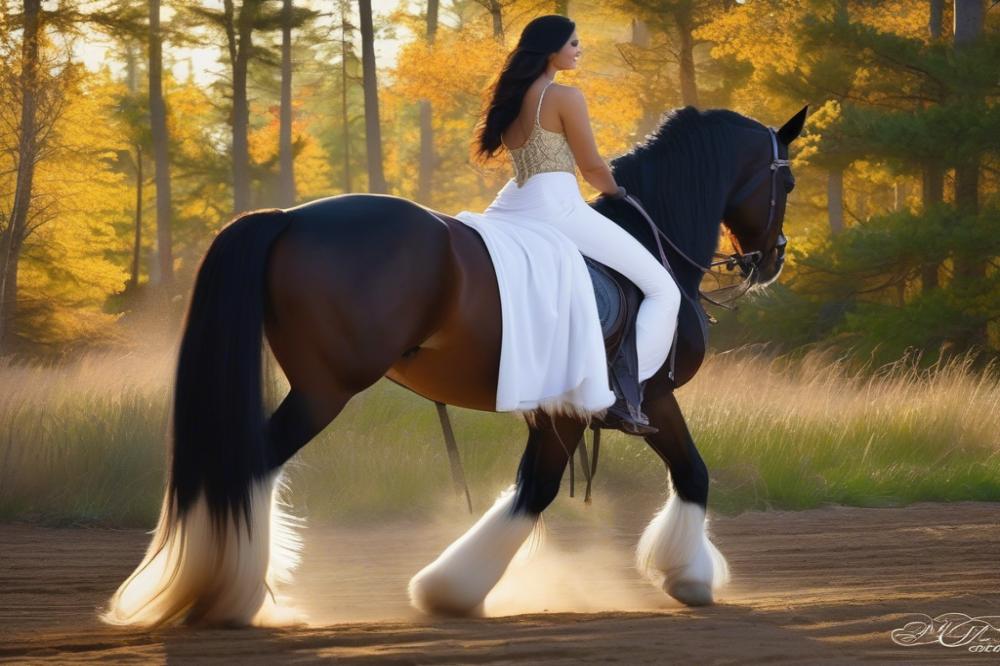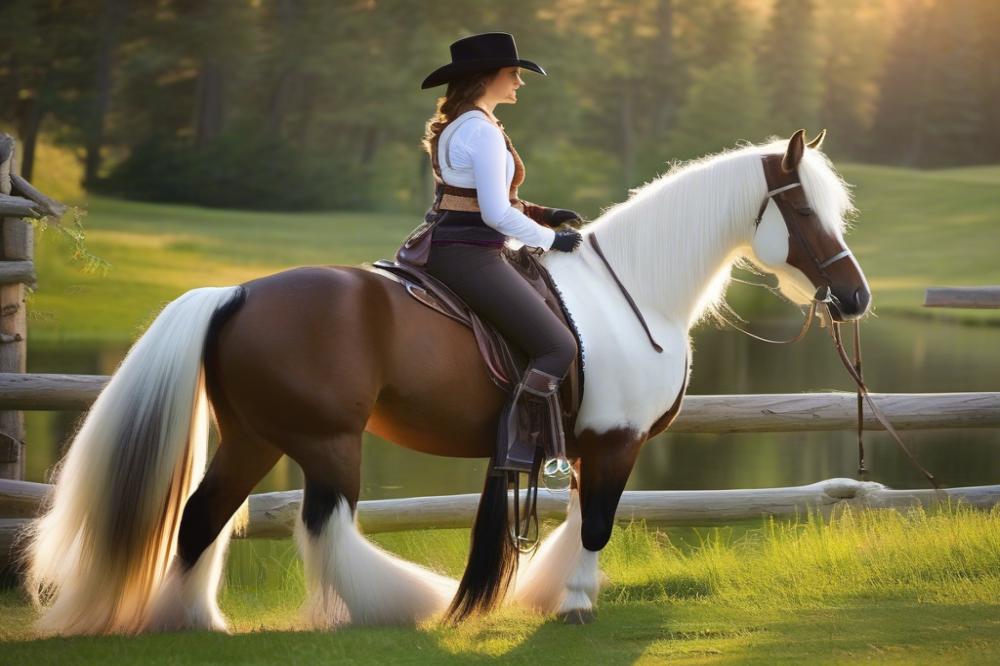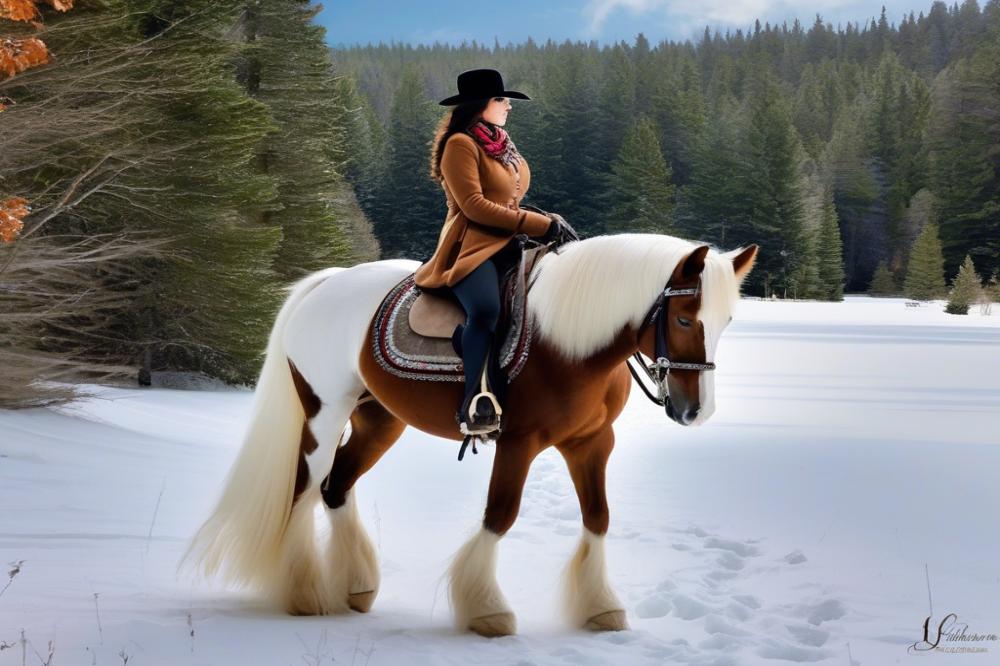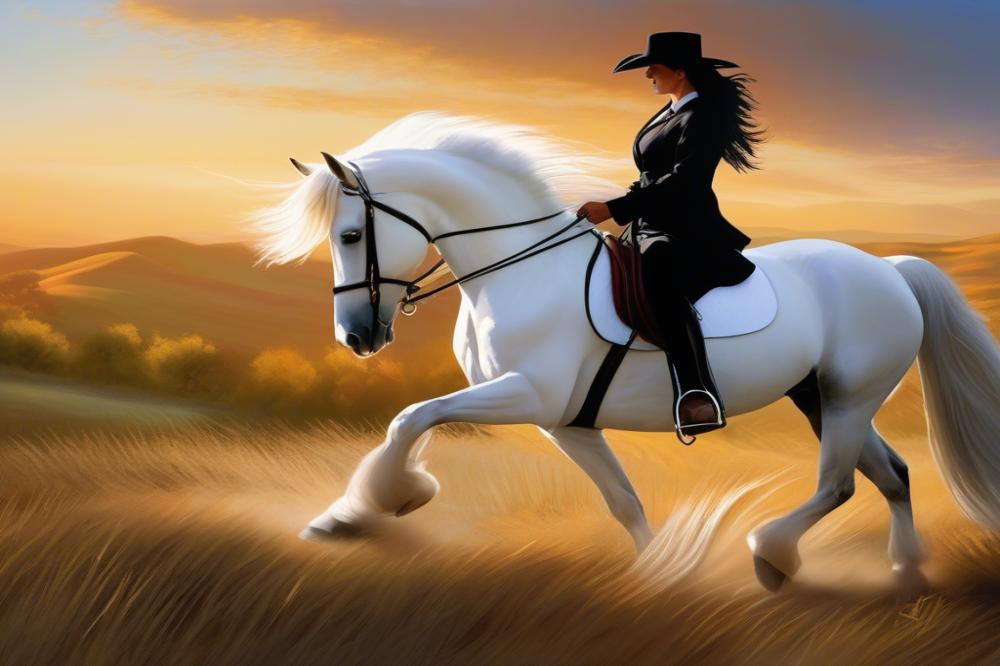Importance of balance in horseback riding
balance plays a crucial role in horseback riding, regardless of the discipline. A rider must maintain stability to communicate effectively with their horse. Good balance allows for smoother movements and helps the horse perform better. When a rider feels secure, the horse can also relax, leading to a more enjoyable experience. Balancing on horseback isn’t just about staying upright; it’s about developing a strong connection with the animal.
Overview of Gypsy Vanner Characteristics

These horses are known for their striking appearance and gentle temperament. Gypsy Vanners often have thick manes and long, flowing tails. Their sturdy build makes them capable of carrying weight comfortably. Alongside their beauty, they possess a calm demeanor, captivating many riders. This breed is not only stunning but also friendly. Such characteristics make them excellent companions for both novice and experienced riders.
Brief on trail riding and Challenges

trail riding offers an exciting way to explore nature on horseback. However, it comes with its own set of challenges. Riders may encounter uneven terrain, sudden inclines, or narrow paths. Maintaining balance is essential during these moments. Unexpected movements can happen, whether from the horse or the environment. Therefore, being prepared and focused is vital. Understanding how to adapt is key. Riding in nature should be enjoyable, and mastering balance can help make it so.
Understanding the Gypsy Vanner

The Gypsy Vanner is a captivating breed known for its striking appearance. A notable characteristic is its heavy feathering on the lower legs. This coat not only looks beautiful but can serve as protection against rough terrain. Their long, flowing mane and tail further enhance their charm. Combined with a stocky build, this breed offers a solid foundation for riders.
When it comes to behavior, Gypsy Vanners are typically gentle and kind. They may show a calm demeanor, making them well-suited for trail riding. Trust is vital in the bond between rider and horse, especially with this breed. Many riders find them willing and eager to please. Their relatively even temperament allows for a smooth ride.
Understanding these features is crucial for effective riding. The strong body provides stability, which aids in balance. Riders can benefit from the horse’s sturdy legs, especially when navigating rocky paths. A Gypsy Vanner often communicates through its movements, offering clues about its comfort level. Recognizing these signals can enhance the riding experience significantly.
With the right approach, a rider can enjoy the journey with a Gypsy Vanner. Taking time to bond will cultivate trust and ensure a safer ride. Awareness of the horse’s behavior allows for better decision-making while on the trail. So, knowing their traits can truly elevate the adventure.
Essential Balance Techniques for Gypsy Vanner riding
Balance plays a crucial role in horseback riding. When riding a Gypsy Vanner, proper balance can help improve your control. Maintaining stability allows for a smoother ride, especially on trails. Unstable riders are more likely to face difficulties. Good balance contributes to overall safety, for both rider and horse.
Key riding techniques to Maintain Balance
Using the correct riding techniques is essential. Keep your seat centered in the saddle. This position distributes your weight evenly and helps you stay grounded. Engaging your core muscles can further stabilize you. Try to anticipate the horse’s movements. When the Gypsy Vanner shifts, your body should react naturally. Shift your weight slightly in harmony with the horse’s rhythm. Balance is about coordination and awareness.
Rider Posture and Its Effects on Stability
Posture significantly influences your stability while riding. Sit up straight with your shoulders back. Good posture opens your hips, promoting a relaxed seat. Avoid leaning forward or backward, as this can throw off your balance. Your legs should hang naturally alongside the horse’s sides. Keep your heels down and your toes pointed slightly upward. This position not only aids balance but also allows you to cue your horse effectively.
Remember, the eyes also play a part in maintaining balance. Look where you want to go. Your body will naturally follow your gaze. Avoid staring at the ground, as this can disrupt your equilibrium. Focus on the trail ahead to help your balance. In essence, combining these techniques will enhance your riding experience.
Equestrian Tips for Enhancing Balance on Trails
Exercises to Improve Core Strength and Stability
Building core strength is vital for maintaining balance while riding. One effective exercise is the plank. Hold this position to engage your core muscles. Another option is doing yoga. Poses like the boat pose strengthen the abdomen and enhance stability. Incorporating balance exercises at home can also help. Try standing on one leg, then the other, for several seconds. This simple act trains your body to adapt to shifting weight. Consider using a balance board during your workouts. It mimics the movements you experience while riding.
Common Trail Challenges That Affect Balance
Trails can present various obstacles that disrupt your stability. Uneven ground is a major culprit. Roots, rocks, and dips can suddenly throw you off balance. Steep inclines are another challenge. Going uphill requires adjusting your weight forward, while downhill demands you lean back. Water crossings can also be tricky. Slippery surfaces or sudden drops can catch riders off guard. Always be on alert for wildlife or other distractions. They can cause your horse to spook, which might lead to a loss of balance.
Strategies to Stay Balanced During Sudden Movements
Staying balanced during sudden movements is crucial for your safety. First, practice your grip on the reins. A firm hold can help you regain control after unexpected changes. Lowering your center of gravity can also stabilize you. Bend your knees and align your body with the horse’s movements. When your horse shifts suddenly, use your core muscle engagement to absorb the motion. Keep your eyes up and focused on the trail ahead. This will help you anticipate changes more effectively. Breathing evenly can also help you stay calm and balanced. Deep breaths can ease tension in your body.
Integrating Horse Care with Riding
Conditioning is vital for the Gypsy Vanner. These horses are heavy and muscular. They benefit greatly from regular exercise. A balanced regimen helps build strength and stamina. This preparation can only enhance your time on the trails.
Consider your horse’s overall well-being. Physical fitness directly influences their performance. Regular grooming is just as important as riding. It helps keep their coat healthy and allows you to check for injuries. Being aware of any changes in your horse’s body is crucial.
Nutrition plays a significant role in how a horse behaves on trails. Selecting the right feed can make all the difference. High-quality hay and grains will fuel them for long rides. Supplements can also support their energy and joint health. When a horse feels good, they are more likely to be calm and responsive.
Hydration also matters a lot. Always provide fresh, clean water before and after rides. A well-hydrated horse is happier and more willing. If you’re heading out for long periods, consider bringing along water for your horse.
Monitoring your horse’s health is necessary. Look out for signs of fatigue or stress. Regular veterinary check-ups will help catch any potential issues early. A healthy horse leads to a safer and more enjoyable ride. Prioritize your horse’s needs, and they will reward you with their trust and performance.
Trail Safety and Balance
Safety Precautions When Riding on Trails
Before heading out, a helmet is essential. It protects your head from unexpected bumps or falls. Check the trail conditions too. Wet or muddy paths can cause slipping. Take a buddy along whenever possible. Riding with a friend enhances safety and adds enjoyment. Keep your horse close to the trail’s edge when passing through narrow areas. This simple act maintains stability for both you and your steed. Always be aware of your surroundings. Wildlife, cyclists, and other riders may appear without warning.
How Balance Contributes to Rider Safety
Maintaining balance while riding serves as a key factor for safety. A stable rider can react quickly to sudden movements. This is crucial when navigating diverse terrains. Use your core muscles to stay centered. Engaging your core helps absorb any jolts from uneven ground. Your legs should remain relaxed and grip the saddle gently. Proper posture enhances not just comfort but also control. When you feel secure, your horse can also sense this confidence, leading to a smoother ride.
Tips for Navigating Challenging Terrain
Approach obstacles with caution. Take your time as you move over rocks or logs. Let your horse pick its way through tough spots. This natural behavior avoids unnecessary risks. When descending steep trails, lean back slightly. Shifting your weight helps keep your balance in check. In contrast, rising slightly out of the saddle on an ascent can help maintain stability. Don’t forget to communicate with your horse. Subtle cues can guide your actions and intentions. Practice makes perfect; if you know the trail well, every ride will become easier.
Bringing It All Together
As we wrap up our discussion on riding a Gypsy Vanner, let’s recap the important balance techniques and riding tips that can help you. Maintaining a centered position in the saddle is crucial. Remember to engage your core muscles while keeping your heels down. Standing in a balanced position during trotting or cantering is essential to stay in sync with your horse’s movements.
Practice makes all the difference. The more you ride, the more you will develop confidence and skill. Whether it’s going on gentle trails or navigating some tricky terrain, allow yourself to grow with each ride. Feel free to savor the connection you create with your horse. Embrace those quiet moments when you both understand each other without words. Each journey together can enhance your experience.
Horseback riding is not just about skill but also the bond between rider and horse. Balance plays a big role in this relationship. When you find your rhythm, the ride becomes more enjoyable. A well-balanced rider leads to a more comfortable and responsive horse. As you continue to explore the trails on your Gypsy Vanner, remember to be patient with yourself. Celebrate each progress, no matter how small.
In the end, your journey on horseback is as much about the experience as it is about mastering techniques. The joy of riding and the partnership with your horse create unforgettable memories. With every ride, you build not only your ability but also trust and communication. So take a deep breath, grab those reins, and enjoy the adventure ahead!



